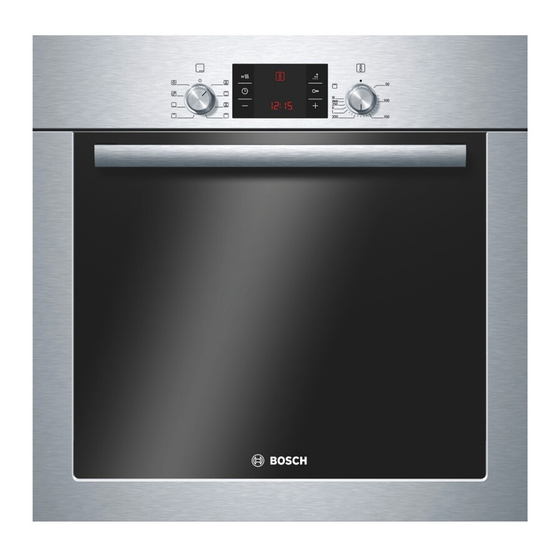Bosch HB 43R Series Manual de instruções - Página 17
Procurar online ou descarregar pdf Manual de instruções para Forno Bosch HB 43R Series. Bosch HB 43R Series 24 páginas.

Pastries
Pastries and biscuits
Meringues
Empty puffs
Enamel baking tray
Macaroons
Aluminium tray + flat oven tray
Aluminium tray + universal deep tray
Extra baking trays may be obtained as optional accessories from specialist retail outlets.
Practical cooking tips and suggestions
If you want to use your own recipe.
How to check whether your sponge cake is
ready.
The cake is too flat.
The cake has a peaked centre, but the edges
have shrunken.
If the cake is too brown on top.
The cake is too dry.
The bread or cake (fruit cake, for example) looks
fine on the outside but still has soft (soggy)
areas inside.
Biscuits are not evenly browned.
Fruit cake is uncooked at the bottom.
Juice from the fruit oozes out.
Small pastries made with yeast may stick
together during baking.
Products have been baked on different levels.
Biscuits on the upper tray are darker than those
on the lower tray.
Baking moist cakes produces condensation.
Meat, poultry, fish
Cookware
Any heatproof cookware can be used. For large roasts, the
enamel tray can also be used.
It is best to use glass containers. Check that the lid of the
cookware will fit and close properly.
If using enamel containers, add more liquid.
When using stainless steel pans, the meat does not brown well
and may even be left rare. If so, lengthen the cooking time.
Data shown in tables:
Uncovered cookware = open
Covered cookware = closed
Always place cookware in the centre of the wire shelf.
3
1+3
1+3
3
2
3
1+3
1+3
You can use a similar one to that listed in the cooking table.
Ten minutes before the end of the cooking time indicated in the recipe, test the
thickest part of the cake with a thin wooden skewer. The cake is ready when the
skewer comes out clean, with no traces of cake mix left on the skewer.
Next time, try using less liquid or reduce the oven temperature by 10 degrees.
Ensure you mix the batter according to the times given in the recipe.
Do not grease the tin. Once the cake is ready, use a knife to carefully remove it
from the tin.
Position the cake lower in the oven, reduce the oven temperature and bake it for
longer.
Use a skewer to make small holes in the finished cake. Pour a few drops of fruit
juice or alcohol over the cake. Next time, increase the oven temperature by
10 degrees and reduce the cooking time.
Next time, use less liquid and leave the product for a little longer in the oven, at
a lower temperature. The bases of cakes with juicy toppings should be baked
first on their own. Then sprinkle chopped almonds or breadcrumbs on the base
before adding the topping. Follow the recipe and observe the cooking times.
Select a lower temperature; the biscuits will be browned more uniformly. Bake
more delicate pastries with top and bottom heating
ing greaseproof paper may also affect air circulation. Always trim it to fit the bak-
ing tray.
Next time, put the cake on a lower level.
Next time, use the universal tray if available.
Leave a space of about 2 cm between them. Then they will have enough space
to rise and brown on all sides.
Always use the hot air
N
Although several baking trays may be placed in the oven at the same time, this
does not mean that they will necessarily all be ready at the same time.
Condensation may form when baking. Some of this moisture may evaporate via
the door handle, and drops of condensation may form on the control panel or on
the front of nearby kitchen units. The oven is physically designed with this in
mind.
Hot glass cookware should be placed on a dry dishcloth. The
glass could shatter if rested on a wet or cold surface.
Roasting
Add in a little liquid if the meat is lean. Cover the base of the
ovenware with approx. ½ cm of liquid.
Add liquid generously for pot roasts. Cover the base of the
ovenware with approx. 1 - 2 cm of liquid.
The amount of liquid depends on the type of meat and the
material the ovenware is made of. If preparing meat in an
enamelled roasting dish, it will need a little more liquid than if
cooked in glass ovenware.
Roasting dishes made from stainless steel are not ideal. The
meat cooks more slowly and browns less fully. Use a higher
temperature and/or a longer cooking time.
in °C
150-160
%
140-150
N
140-150
N
80-90
N
190-210
%
110-130
%
100-120
N
100-120
N
function when baking products on different levels.
utes
20-30
20-30
20-30
180-210
30-40
30-40
35-45
35-45
%
on one level. Overhang-
17
